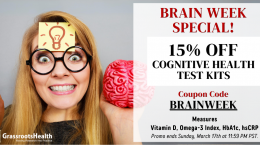Published on May 20, 2024
Is the H Factor still the biggest health breakthrough of the century?
Key Points
- Homocysteine is associated with an increased risk of over 100 diseases or adverse outcomes which are listed at the end of this article, including almost all brain and mental health disorders, from childhood to old age, including dementia and Alzheimer’s
- In those with cardiovascular disease having a H score above 20 increases risk of death by almost five times, and every 5 point increase increases risk by a third; a recent report of almost three thousand cardiovascular patients found that risk of death was almost three times higher for those in the top quartile of Hcy (>15.6) compared with those in the lowest quartile below <9.8
- Homocysteine testing, however, is only truly accurate if measured after fasting for 12 hours with water only being drunk. Both coffee and alcohol affect homocysteine levels, as does eating a protein-rich meal. It is also advised not to take B vitamin supplements during this time or possibly for 24 hours before you test.
Buy Your at-home Homocysteine Test from Food for the Brain Here

Written by Patrick Holford
You may have never heard of it, let alone know your ‘H’ score, but in your bloodstream there exists a toxic amino acid, largely a consequence of sub-optimal B vitamin status, which if raised (above 11µmol/L), is associated with an increased risk of over one hundred diseases, and accelerates brain shrinkage.
It’s called homocysteine and I consider it more important to know than your weight, your glucose, cholesterol, iron, or any other marker, especially if you intend to become pregnant, are over 40, or have any memory, mental health, neurological or cardiovascular concerns.
I first wrote about it in 2003 in my book The H Factor describing it as ‘the biggest health breakthrough of the century’. Reviewing the book, ITV’s This Morning Doctor, Chris Steele, said ‘Homocysteine is the new cholesterol. It’s potentially your most important health statistic.’ In Ireland’s Late Late Show, I tested the host, Pat Kenny, and revealed his level to be way too high (above 15µmol/L). It was his wake up call as he was, according to his wife, heading for a heart attack with a poor diet and lots of stress, coffee and alcohol, all of which raise homocysteine.
Now, twenty years on, we know that homocysteine is associated with an increased risk of over 100 diseases or adverse outcomes which are listed at the end of this article, including almost all brain and mental health disorders, from childhood to old age, including dementia and Alzheimer’s.
Technically we can call homocysteine a ‘biomarker’ which is the title of a very important paper ‘Homocysteine – from disease biomarker to disease prevention’ by Professors David Smith and Helga Refsum (1). If you are a health professional or nutritional therapist, I strongly recommend you read this seminal paper.
David Smith is the Emeritus Professor of pharmacology at the University of Oxford, where he was the Deputy Head of the Faculty of Medical Science. Helga Refsum is a Professor of Nutrition at the University of Oslo in Norway and formerly a professor of pharmacology. Helga could rightly be called the Queen of Homocysteine because her research (the Hordland study that started back in 1992, measuring homocysteine in 18,000 men and women in Norway and tracking their health and the diseases), more than any other, has put this vital biomarker on the map.
Homocysteine first came to my attention when Dr Kilmer McCully in the US discovered that children who were dying young from heart attacks had high levels. This was due to a genetic disorder that leads to homocysteine accumulation in the blood, which then damages the arteries. I wrote about this in my first book, The Whole Health Manual, in 1981.
So, here we are 40 years later and still, few people know about it, far less know their H score and, worse than that, there has been a concerted effort, largely orchestrated by misleading and wrongful science, to keep the lid on it.
Why?
I believe because there is no patentable drug that lowers homocysteine – only inexpensive vitamins.
What is more, having a level above 11µmol/L is not at all uncommon. If you are over 60 the odds are high: 40% in the US over 60 have an H score of over 11 (2). It’s probably not much different in the UK but all we know is that two in five adults over 61 in the UK have insufficient B12 to prevent accelerated brain shrinkage (3). In China it’s much worse – those under 30 or over 60 average a score above 15 (4). It is realistic to assume that over a third of older people have an H score over 11.
What is homocysteine and why is it so important?
Many nutrients in the body do not work in the form you ingest them – that is until they get ‘methylated’. This is true, for example, for folate or folic acid. It has to turn into methylfolate to become biologically active. Many vital biochemicals, from adrenalin to insulin, need to be made and broken down – by methylation. Histamine and hormones such as oestrogen are examples. Also toxins, from mercury to arsenic need to be detoxified – by methylation. The genes you’re born with can be ‘activated or expressed’ or ‘downregulated’ or turned off. Methylation does that too. Two-thirds of all cancers are associated with faulty methylation which messes up gene messaging.
Homocysteine rises if you’re not doing methylation properly. This is because there’s a log jam on the way to making the body’s most important ‘methylator’ called s-adenosyl methionine or SAMe for short. Think of it as the conductor of the methylation orchestra. It’s made from an amino acid you eat – methionine. It’s another example of a food nutrient that doesn’t work until it is methylated. This happens thanks to enzymes dependent on vitamins B6, B12 and folate turning it into SAMe. This film shows you how: Methylation & Homocysteine explained
How does your body and brain juggle and keep all these thousands of biochemicals you need every second in the right balance?
It is a veritable biochemical symphony going on 24/7. That’s what SAMe does, adding on and taking away methyl groups with literally billions of methylation reactions every minute. If your homocysteine level is above 11 you are not doing it right.
At a very simplistic level, you could say that a raised homocysteine indicates that you don’t have enough vitamin B6, B12 or folate. These, together with zinc, trimethylglycine (TMG) and N-acetylcysteine (NAC) are given to lower a high homocysteine level (which is abbreviated to Hcy here on in).
Get homocysteine down before getting pregnant
We call Hcy a biomarker, as opposed to a risk factor, as we don’t always know if it is actually causing the problem or just associated with it. That’s also where the chicken and egg story starts. Given that these B vitamins lower Hcy it’s not so surprising to find that many of the diseases that are associated with high Hcy are also associated with low folate or B12. Pregnancy problems are a classic example. With an Hcy above 9 µmol/L, risk of miscarriage and pregnancy complications are higher. A Hcy level of above 9 in the mother during pregnancy predicts more problems, specifically withdrawn behaviour, anxiety/depression, social problems and aggressive behaviour in their child at age 6 (5).
Raised Hcy is a well-known predictor of miscarriage (6) and pregnancy problems (7). But is it homocysteine or a lack of folate or B12? Similarly, neural tube defects, for example, spina bifida, is strongly associated with both lack of folate and raised Hcy. Giving folic acid supplements reduces risk and lowers Hcy. Is Hcy a marker for folate deficiency (yes)? Or is folate deficiency a cause for raised Hcy (yes) and is it actually the Hcy that does the damage (probably)? That’s harder to answer but there are a number of ‘toxic’ consequences of raised Hcy such as damage to the arteries and the brain. Also, many things are generally bad for your health – drinking too much alcohol or coffee, smoking, not exercising, being stressed, having diabetes, not sleeping – all of which are associated with higher Hcy. Suffice it to say that there are plenty of advantages in having an H score below 9, and possibly even lower, with no disadvantages – including less risk of dying.
In those with cardiovascular disease having a H score above 20 increases risk of death by almost five times. Every 5 point increase increases risk by a third (8). A recent report of almost three thousand cardiovascular patients found that risk of death was almost three times higher for those in the top quartile of Hcy (>15.6) compared with those in the lowest quartile below <9.8 (9).
Protect your brain by lowering homocysteine
Hcy damages the arteries including blood vessels in the brain. That’s what Dr Kilmer McCully discovered back in 1969 in children with a genetic disorder. A recent study showed that being in the top quarter for Hcy meant 17 times more risk of cerebrovascular damage (10). But it also cranks up things like p’tau which is a toxic substance known to cause ‘neurofibrillary tangles’ which are one of the hallmarks of Alzheimer’s that big pharma is trying to develop a drug for. They needn’t bother because lowering Hcy with inexpensive B vitamins lowers p’tau (11). It’s just not profitable.
Not surprisingly, if high, Hcy increases the risk of stroke, and giving folate or B12 lowers risk. In this case we can say Hcy is ‘causal’ – as in high levels cause things to happen that lead to stroke or dementia and lowering homocysteine stops or very much slows down those things happening, slowing down brain shrinkage and virtually stopping further memory loss. But, as with many diseases, if you’ve already had a stroke or got Alzheimer’s there is little room for improvement.
Buy Your at-home Homocysteine Test from Food for the Brain Here
Homocysteine for heart disease and stroke
While no one disagrees that high homocysteine predicts risk for heart disease or stroke, some dodgy science more than a decade ago, when the full dynamics of homocysteine and B vitamins weren’t known, cast doubt. One such study in Sweden, called NORVIT, apparently showed no effect from giving B vitamins to people who had had a stroke. ‘The homocysteine hypothesis is dead. Homocysteine is not a causal risk factor. It is an innocent bystander,” declared the author, Dr Bonaa.
We now know he was wrong, and why he was wrong. Smith and Refsum’s paper goes into all the detail, but what has since been learned is this:
>> B vitamins don’t lower risk if you don’t already have a high homocysteine level.
- Anti-platelet drugs (think aspirin) and statins interfere with the beneficial action of B vitamins.
- B12 is poorly absorbed and certain older patients with poor absorption or kidney disease are less likely to respond to oral B12 (but might get benefit from B12 injections).
- Also, lowering homocysteine with B vitamins BEFORE a person has had a stroke or a heart attack, does much more effectively reduce the likelihood of them having one.
This has led to serious cardiology scientists, such as Professor David Spence, who realised the problems with a major study he had conducted, called VISP, and reanalysed the results to find a clear benefit. ‘Call off the funeral’, he declared.
But, for some, sadly, including the so-called National Institute of Clinical Excellence (NICE), now called the National Institute of Health and Care Excellence, there will be no exhumation for homocysteine.
That’s unfortunate because two-thirds of cardiovascular deaths in the elderly happen to people with high Hcy. Not paying any attention to the actual scientific evidence due to a former misguided bias is not health, care, or excellence.
Is there a mental or neurological illness that isn’t cranked up by high homocysteine?
Have a look at the list of diseases below, all strongly associated with homocysteine. Take Parkinson’s for example. A recent meta-analysis shows that both homocysteine, vitamin B12, and folate status predict the onset and development of Parkinson’s (12).
The point is that if you’re over 60 or have any concerns about any of these conditions, and especially if you already have a serious degenerative disease such as Parkinson’s, multiple sclerosis, dementia or cardio or cerebrovascular disease, it is vital to check your homocysteine level and then act accordingly. If your specialist hasn’t done this they are not doing their job properly. The science is in plain sight.
Plasma total homocysteine as a disease biomarker
Disease/Syndrome
Insufficient B vitamin status
Folate, B12, B6, B2
Inborn errors of homocysteine and vitamin metabolism and transport
Cardiovascular diseases
Myocardial infarction
Severity of coronary artery disease
Hypertension
Restenosis of coronary arteries and adverse outcomes after angioplasty
Stroke
Stroke mortality
Silent brain infarct
Carotid plaque area, stenosis, intima-media thickness
Intracerebral arterial stenosis
Peripheral vascular disease
Venous thrombosis
Arterial aneurysm
Arterial stiffness
Atrial fibrillation
Cerebral small vessel disease
Cerebral microbleeds
Disruption of blood-brain-barrier
Endothelial mediated dilatation – impairedVascular complications of diabetes
Raynaud’s syndrome
Takayasu arteritis
Thromboangiitis obliterans (Buerger’s disease)
Moyamoya disease
Behçet disease
Erectile dysfunction
Other syndromes
Mortality
Frailty
Cancer
Metabolic syndrome
Obesity
Bone disease, osteoporosis
Inflammatory bowel disease, Crohns
Non-alcoholic fatty liver disease
Renal insufficiency, chronic kidney disease
Chronic obstructive pulmonary disease
Alcohol abuse
Psoriasis
Vitiligo
Sclerosis
Sickle-cell disease
Burning mouth syndrome
Atrophic glossitis
Quality of life in centenarians
Obstructive sleep apnea
Hypothyroidism
Telomere shortening
Systemic lupus erythematosus (SLE)
Dermatomyositis
Inflammatory response
Periodontal disease
Hearing loss
Gout
Blood lead concentration
Maternal tHcy
Pregnancy complications
Outcomes in child
– small for gestational age, fetal growth
– neural tube defects
– congenital heart disease
– orofacial clefts
– renal function
– child cognition
– child behaviour
– schizophrenia
– autism spectrum disorder
Central nervous system diseases
Incident Alzheimer’s disease/dementia
Vascular dementia, vascular cognitive impairment
Post-stroke cognitive impairment
Cognitive decline after concussion
Cognition in children
Cognition in elderlyInitiation of cognitive decline in ageing
Conversion from cognitive impairment to dementia
Cognitive decline in dementia
Atrophy of brain tissue/gray matter
Atrophy of brain white matter
White matter damage
Alzheimer brain pathology (P-tau)
Multiple sclerosis
Cognitive decline in Parkinson’s disease
Depression
Bipolar disorder
Schizophrenia
Amyotrophic lateral sclerosis/ Motor Neuron Disease
Multiple System Atrophy
Impaired motor development in infant
Early neurological deterioration after stroke
Glasgow coma scale
Migraine
Autism spectrum disorder
The above lists diseases and syndromes for which there are reports of association with raised total homocysteine. Reproduced with the permission of the authors Professors David Smith and Helga Refsum from the paper Smith AD, Refsum H. Homocysteine – from disease biomarker to disease prevention. J Intern Med. 2021 Oct;290(4):826-854. doi: 10.1111/joim.13279. Epub 2021 Apr 6. PMID: 33660358. © 2021 The Association for the Publication of the Journal of Internal Medicine 3 Journal of Internal Medicine
Buy Your at-home Homocysteine Test from Food for the Brain Here
Testing and Lowering Homocysteine (it’s now easier than ever!)
 Despite almost 29,000 studies on homocysteine, getting your doctor to test your homocysteine is close to impossible. It shouldn’t be because every hospital laboratory can do this simple laboratory test. It need not be expensive.
Despite almost 29,000 studies on homocysteine, getting your doctor to test your homocysteine is close to impossible. It shouldn’t be because every hospital laboratory can do this simple laboratory test. It need not be expensive.
All these studies refer to total plasma homocysteine, that is the level found not in red blood cells but in the clear serum part of blood. The issue there regarding testing has been the need to separate or spin the blood shortly after taking the sample or pass the blood through a plasma separator as some home test kits have attempted. I’ve tested home test kits and have not been impressed with the correlation with serum/plasma homocysteine, which is the gold standard.
However, a breakthrough with both the fixing of blood taken using a dry blood spot, and the testing process, has occurred which now means that we have an accurate and inexpensive way to test homocysteine from a dry blood spot supplied from a home test kit. This is now.
The validation of this test is extremely good (with a R2 of 0.93 for those who know statistics). This also means that there will be no false positives or negatives.
Homocysteine, however, is only truly accurate if measured after fasting for 12 hours with water only being drunk. Both coffee and alcohol affect homocysteine levels, as does eating a protein-rich meal. I also advise not taking B vitamin supplements during this time or possibly for 24 hours before you test.
Fortunately, Hcy is easily lowered.
The simplest and most effective way to do this is with B vitamin supplements at the right dosage. Click here to see not only how much to supplement but which supplements there are that provide these doses.
Most critical is the amount of vitamin B12 they provide.
The basic Dietary Reference Value that you see on supplements is 2.5mcg. Few provide more than 10mcg, which is sufficient if you don’t have raised Hcy. This will do nothing to lower a high H score. Professor’s Smith and Refsum recommend 500mcg a day – that’s two hundred times higher. This is both safe and effective especially if taken alongside B6 (20mg) and methylfolate (400mcg). Also, it doesn’t take so long you bring your level down. I’ve had clients with H levels from 30 up to over 100 µmol/L bring theirs down to below 9 in under three months.
Other wise choices are to eat greens, beans, nuts and seeds which are high in folate; eat seafood and eggs, high in B12 and phospholipids, as well as omega-3, which methylation helps bind together to make healthy cell membranes; don’t smoke or drink in excess (one 125ml of red wine doesn’t affect homocysteine levels); don’t drink more than one coffee a day; reduce stress and insomnia and keep fit.
We are now excited to announce that after much work we have our at-home pin prick homocysteine blood test that you can order and test in your own home.
Click the link above to preorder your test today, then please also do the charity’s free online Cognitive Function Test, followed by the diet and lifestyle questionnaire. In that way, you become a Citizen Scientist.
Buy Your at-home Homocysteine Test from Food for the Brain Here
Thank you for reading!
Food for the Brain is a non-for-profit educational and research charity that offers a free Cognitive Function Test and assesses your Dementia Risk Index to be able to advise you on how to dementia-proof your diet and lifestyle.
By completing the Cognitive Function Test you are joining our grassroots research initiative to find out what really works for preventing cognitive decline. We share our ongoing research results with you to help you make brain-friendly choices.
Please support their research by becoming a Friend of Food for the Brain.
Make Sure You Are Getting Enough Vitamin D, Omega-3s, and Magnesium as Well!
 Having and maintaining healthy vitamin D levels and other nutrient levels can help improve your health now and for your future. Choose which additional nutrients to measure, such as your omega-3s and essential minerals including magnesium and zinc, by creating your custom home test kit today. Take steps to improve the status of each of these measurements to benefit your overall health. With measurement you can then determine how much is needed and steps to achieve your goals. You can also track your own intakes, symptoms and results to see what works best for YOU.
Having and maintaining healthy vitamin D levels and other nutrient levels can help improve your health now and for your future. Choose which additional nutrients to measure, such as your omega-3s and essential minerals including magnesium and zinc, by creating your custom home test kit today. Take steps to improve the status of each of these measurements to benefit your overall health. With measurement you can then determine how much is needed and steps to achieve your goals. You can also track your own intakes, symptoms and results to see what works best for YOU.
Enroll in D*action and Test Your Levels Today!
References
1 Smith AD, Refsum H. Homocysteine – from disease biomarker to disease prevention. J Intern Med. 2021 Oct;290(4):826-854. doi: 10.1111/joim.13279. Epub 2021 Apr 6. PMID: 33660358.
2 Pfeiffer CM, Osterloh JD, Kennedy-Stephenson J, Picciano MF, Yetley EA, Rader JI, Johnson CL. Trends in circulating concentrations of total homocysteine among US adolescents and adults: findings from the 1991-1994 and 1999-2004 National Health and Nutrition Examination Surveys. Clin Chem. 2008 May;54(5):801-13. doi: 10.1373/clinchem.2007.100214. Epub 2008 Mar 28. PMID: 18375482.
3 Vogiatzoglou A, Refsum H, Johnston C, Smith SM, Bradley KM, de Jager C, Budge MM, Smith AD. Vitamin B12 status and rate of brain volume loss in community-dwelling elderly. Neurology. 2008 Sep 9;71(11):826-32. doi: 10.1212/01.wnl.0000325581.26991.f2. PMID: 18779510.
4 Xu R, Huang F, Wang Y, Liu Q, Lv Y, Zhang Q. Gender- and age-related differences in homocysteine concentration: a cross-sectional study of the general population of China. Sci Rep. 2020 Oct 15;10(1):17401. doi: 10.1038/s41598-020-74596-7. PMID: 33060744; PMCID: PMC7566483.
5 Roigé-Castellví J, Murphy M, Fernández-Ballart J, Canals J. Moderately elevated preconception fasting plasma total homocysteine is a risk factor for psychological problems in childhood. Public Health Nutr. 2019 Jun;22(9):1615-1623. doi: 10.1017/S1368980018003610. Epub 2019 Jan 14. PMID: 30636652; PMCID: PMC10261079.
6 Li J, Feng D, He S, Wu Q, Su Z, Ye H. Meta-analysis: association of homocysteine with recurrent spontaneous abortion. Women Health. 2021 Aug;61(7):713-720. doi: 10.1080/03630242.2021.1957747. Epub 2021 Aug 1. PMID: 34334120.
7 Dai C, Fei Y, Li J, Shi Y, Yang X. A Novel Review of Homocysteine and Pregnancy Complications. Biomed Res Int. 2021 May 6;2021:6652231. doi: 10.1155/2021/6652231. PMID: 34036101; PMCID: PMC8121575.
8 Fan R, Zhang A, Zhong F. Association between homocysteine levels and all-cause mortality: A dose-response meta-anal- ysis of prospective Studies. Sci Rep. 2017;7:4769.
9 Pusceddu I, Herrmann W, Kleber ME, Scharnagl H, Hoff- mann MM, Winklhofer-Roob BM, et al. Subclinical inflam- mation, telomere shortening, homocysteine, vitamin B6, and mortality: the Ludwigshafen Risk and Cardiovascular Health Study. Eur J Nutr. 2020;59:1399–411.
10 Teng Z, Feng J, Liu R, Ji Y, Xu J, Jiang X, Chen H, Dong Y, Meng N, Xiao Y, Xie X and Lv P (2022) Cerebral small vessel disease mediates the association between homocysteine and cognitive function. Front. Aging Neurosci. 14:868777. doi: 10.3389/fnagi.2022.868777
11 Read both Xia, Y., Prokop, S. & Giasson, B.I. “Don’t Phos Over Tau”: recent developments in clinical biomarkers and therapies targeting tau phosphorylation in Alzheimer’s disease and other tauopathies. Mol Neurodegeneration 16, 37 (2021). https://doi.org/10.1186/s13024-021-00460-5; also LiJ-G,ChuJ,BarreroC,MeraliS,Pratico`D.2014.Homocysteine exacerbatesβ-amyloid, tau pathology, and cognitive deficit in a mouse model of Alzheimer’s disease with plaques and tangles. Ann. Neurol. 75:851–63; also Shirafuji N et al Homocysteine Increases Tau Phosphorylation, Truncation and Oligomerization. Int J Mol Sci. 2018 Mar 17;19(3):891. doi: 10.3390/ijms19030891. PMID: 29562600; PMCID: PMC5877752; also Bossenmeyer-Pourié C et al. N-homocysteinylation of tau and MAP1 is increased in autopsy specimens of Alzheimer’s disease and vascular dementia. J Pathol. 2019 Jul;248(3):291-303. doi: 10.1002/path.5254. Epub 2019 Mar 19. PMID: 307349
12 Quan Y, Xu J, Xu Q, Guo Z, Ou R, Shang H and Wei Q (2023) Association between the risk and severity of Parkinson’s disease and plasma homocysteine, vitamin B12 and folate levels: a systematic review and meta-analysis. Front. Aging Neurosci. 15:1254824. doi: 10.3389/fnagi.2023.1254824





